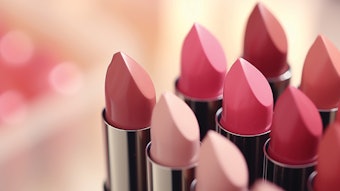As most formulators—who are also consumers—know, fragrance is a major deciding factor when it comes to choosing a personal care product. For example, many women will not buy a product they think smells masculine, just as most men will not choose a product they think smells feminine. But because fragrance is a subjective experience, how can a formulator translate a marketing concept into objective terms to incorporate it in a finished product?
To investigate, Cosmetics & Toiletries magazine attended a recent fragrance workshop, hosted by Bell Fragrances & Flavors, and learned about the Seven Olfactive Fragrance Families. These classifications provide some basic fragrance terminology to assist formulators in choosing a fragrance that fulfills not only their needs but also the needs of their marketing departments.
Fragrance Genealogy
Adding to the translation challenge is the fact that the terminology can also differ between fragrance houses and perfumers. However, Mike Natale, director of marketing for Bell, believes that these differences can be rectified by focusing on the common fragrance families. “Fragrance houses and perfumers often have their own language, but with this classification, we can all speak the same language,” he said.
Fragrance genealogy is the company’s way of describing the primary notes of a fragrance. Natale explained, “Fragrance genealogy is similar to the family tree in that it helps characterize fragrance notes, descriptors and chemicals.” This metaphor can be extended by describing the olfactive fragrance family as the “grandparents;” the olfactory fragrance as the “parents, uncles and aunts;” and the olfactory fragrance descriptors as the “children, cousins and grandchildren.” The seven olfactory fragrance families, including citrus, fougère, green, fruity, floral, oriental and chypre, classify nearly 90% of all fragrances.
Citrus, Fougère, Green and Fruity
One of the oldest and most popular olfactory fragrance families is citrus, according to Robert Siegel, a perfumer at Bell. This family incorporates citrus fruits such as bergamot, lemon, mandarin, orange, grapefruit, petitgrain, tangerine and aldehydes as the primary note. Conversely, the fruity family utilizes brightly colored and tropical fruits such as berry, peach, plum, cassis, apricot, prune, mango, cherry, apple, melon, pineapple, pear, banana and kiwi as their top notes—what Siegel refers to as “non-citrus notes.” Although this category is frequently used, it often is not the top note.
Also used more often as a component than as the main note is the green olfactory fragrance family. This family refers to the scent of nature and can include notes of grass, tea leaves, herbs, mate and galbanum essential oils, violet leaves and foliage. On the other hand, fougère is a popular top note for men’s fragrances. This family was introduced with Houbigant’s Fougère Royale in 1882, which featured top notes of lavender and bergamot and base notes of oakmoss and coumarin. Today’s fougère now incorporates rustic notes of herbs, spices, woods and conifer trees.
Floral/Fruity vs. Floral/Floral
Many perfumers agree that floral is perhaps the most important fragrance family. Jill Costa, PhD, chief perfumer at Bell, is among them, and finds that there can be significant “movement” in floral fragrances. The floral fragrance family is further divided into the fragrance “parents” of floral/fruity and floral/floral. Floral fragrances have floral dominant notes with animalic or musky base notes. The floral family is large, with subcategories differentiated by the top notes. Descriptors include jasmine, rose, hyacinth, ylang-ylang, orchid, gardenia, etc.
Classic floral/floral fragrances developed between 1900 and 1950 often used expensive naturals such as rose, tuberose, jasmine, vanilla, neroli and musk, whereas contemporary floral/floral fragrances use more synthetic floral scents. Costa explained, “Because [contemporary floral/floral] fragrances branch outside of naturals, the perfumer gets a bigger bouquet of flowers.” Contemporary floral family fragrances also use more white flowers such as tuberose, orange flower and gardenia.
However, Costa described floral/floral fragrances as “shocking” and finds that therefore, more floral/fruity fragrances are used in contemporary floral fragrances. Floral/fruity olfactory fragrance parents combine synthetic floral notes with complementary fruit notes such as apple, melon and berries. This combination, according to Costa, provides more “movement” than the linear floral/floral fragrances, meaning it changes throughout the day. “People do not want a fragrance to smell the same 12 hours later,” she said. More fragrance launches currently are floral/fruity, suggesting this category should be classified by its top notes.
Oriental/Amber
The exotic fragrance family, termed oriental or amber, was described by Michel Jarosz, a senior perfumer at Bell, as including soft, powdery and vanilla notes that combine well with floral and woody accords. He added that the animal warmth and Cistus labdanum, an absolute derived from rock rose, are the forgotten underlying appeal of oriental fragrances. Classic oriental fragrances include citrus, lavender, rose, patchouli, sandalwood, vanilla, tonka, resins (myrrh, opoponax, tolu and labdanum) and animal notes (amber, musk, civet and castoreum). Further, this family includes four olfactory fragrance “parents”: classic oriental, soft oriental, floral/oriental and woody/oriental.
Many animal notes important to this family have disappeared due to regulatory restrictions. These include civet, derived from a Somalian cat; castoreum, exuded from the castor sac of a beaver; musk, once taken from the glands of the musk deer—however, now synthetically manufactured; and ambergris, regurgitated by the sperm whale. Jarosz added, “[natural] musks do not exist anymore.” The use of resins has also dropped due to regulations, as these materials are often unidentifiable by gas chromatography analysis.
Chypre
The chypre family has been challenged perhaps more than any other fragrance family, said Vern Murawski, a senior perfumer at Bell. Chypre is the French name for the island of Cyprus, and this term was used by François Coty in 1917 to describe a woodsy, mossy, citrusy perfume created by the company. Although this fragrance family has been around for nearly 100 years, the regulation of its main components has nearly eradicated it. The base notes of oakmoss and Cistus labdanum, which are both native to Cyprus and the Mediterranean climates, are highly regulated and difficult to find, respectively.
The chypre family includes two fragrance “parents,” heavy chypre and light chypre. While heavy chypre has an earthy base with citrus top notes and subtle floral notes, light chypre has a dry base note with a citrus, amber or woody emphasis. Murawski noted, “Some people want to [remove] this family because it is hard to describe but instead, perfumery has expanded it.” He added that oakmoss is making a comeback since it has been created by raw material manufacturers to pass regulation; the International Fragrance Association determined that moss extracts should contain less than 1 ppm atranol and chloroatranol. On the other hand, Murawski observed that throughout the years, “many fragrances have changed from chypre to other categories [due to] regulatory and sourcing problems.”
Application in Personal Care
The perfumers at the event agreed that trends in fine fragrance are often translated into personal care products. This “trickle down” effect is evident in recent product launches featuring scents such as passion fruit, Japanese cherry blossom, roses and honey, pomegranate and mango, and honeysuckle and lemon verbena. One special consideration Costa noted regarding fragrances for personal care is that they must be more singular due to potential interactions with other functional ingredients. However, she added that personal care fragrances should be “created for the experience,” meaning the fragrance should change depending on its use, i.e., while showering or left on the hair or body. She concluded that compared with fine fragrance, “There is not as much movement in personal care product fragrance.”










